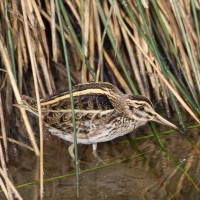Descrizione
The area around Horn kyrka is a quite good site for geese with hundreds of Oca granaiola della taiga, Oca selvatica, and Oca canadese found most years. Often with lesser amounts of Oca lombardella, Oca granaiola della tundra, Oca zamperosee, and Oca facciabianca interspersed. Oca colombaccio has been seen. Most geese are found by Rien (marked with a star on the map) in late Febuary and March.
During the spring Riens water overflow and large amounts of open water form. When this happens large amounts of Germano reale (at most 200), and Alzavola (at most 150) rest in the area. Among these ducks you can observe smaller amounts of Fischione, Canapiglia, Fischione, Codone (uncommon), Mestolone (uncommon), and Marzaiola (rare). Sometimes also some diving ducks. But since water levels vary each spring the amount and variation of ducks at Rien vary accordingly. The wetland at Hornebergs holds permanent water, and usually some dabbling ducks, but not in the same amount. Horn Marsh along with its ponds is also quite good for small amounts of different dabbling ducks.
Diving ducks are most usually found in Åsunden with Smergo maggiore, Moretta, Quattrocchi being common, while Smergo minore and Pesciaiola are uncommon. At Trossbonäs rare diving ducks like Orchetto marino, and Orco marino can be found with luck in April. Even Edredone and Moretta grigia have been seen there.
In spring if Rien has water in late April waders rest there. Piro piro boschereccio, Piro piro culbianco (at most 23), Pavoncella, and Beccaccino (at most 100). On the fields Piviere dorato, at Åsunden Piro piro piccolo sing, and in the forests Beccaccia can be found. During heavy autumn rain Rien can gain enough water for waders such as Pantana, Combattente, Piovanello pancianera, Chiurlo maggiore, Corriere grosso, and Piovanello comune. The fields around Bränna and Västa eneby are pretty good areas for Frullino in November.
Among predatory birds Gheppio, Poiana, Falco pecchiaiolo, Poiana calzata, Aquila di mare, Sparviere, Astore, Falco pescatore, Lodolaio and Albanella reale are all common. Aquila reale, Smeriglio, Falco pellegrino, and Nibbio bruno are all rare but seen some years. The best places for them are Bränna, Rien, and Åshorva.
Large amounts of passerine birds move along the fields around Horn, therefore large amounts of Fanello, Pispola, Cutrettola and other common meadows birds are found along with other rare passerine birds like Pettazzurro, Merlo dal collare, Zigolo della Lapponia (very rare), Zigolo delle nevi, and Fanello nordico. The best places for these are Bränna and Rien.
The wetland around Rien and Hornsberg have large amounts of reed and trees which make them excellent places for nightactive birds. All the common bird are found some years with Re di quaglie, Quaglia, Cannaiola di Blyth, Locustella fluviatile, Voltolino, and Forapaglie macchiettato. Even Schiribilla has been found.
Dettagli
Accesso
Horn is located on the southern shores of lake Åsunden. No good parking spots can be found for most of these places but it is often possible to park alongside the road. The area is best explored with bike or car and perhaps not best suited to tourists because there are few facilities for visitors.





